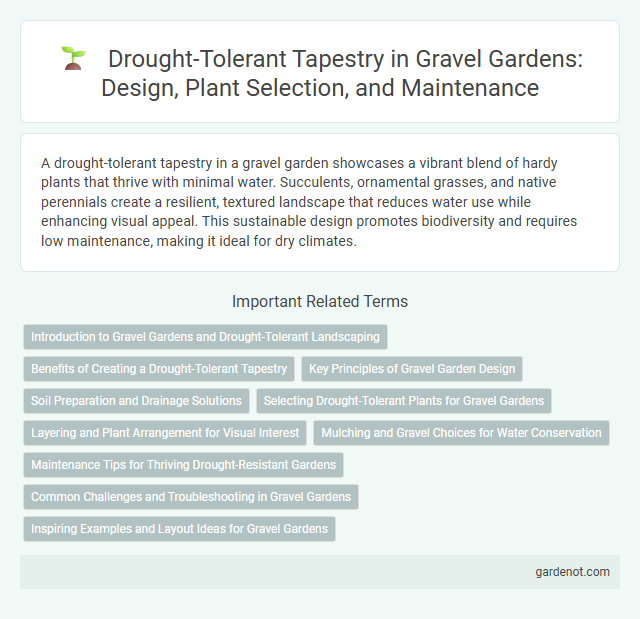A drought-tolerant tapestry in a gravel garden showcases a vibrant blend of hardy plants that thrive with minimal water. Succulents, ornamental grasses, and native perennials create a resilient, textured landscape that reduces water use while enhancing visual appeal. This sustainable design promotes biodiversity and requires low maintenance, making it ideal for dry climates.
Introduction to Gravel Gardens and Drought-Tolerant Landscaping
Gravel gardens utilize a porous substrate and drought-tolerant plants to create sustainable, low-maintenance landscapes ideal for arid climates. These gardens emphasize water conservation by incorporating native species like lavender, sedum, and ornamental grasses that thrive with minimal irrigation. Gravel surfaces enhance soil drainage, reduce evaporation, and inhibit weed growth, making them essential components of efficient drought-tolerant landscaping.
Benefits of Creating a Drought-Tolerant Tapestry
Creating a drought-tolerant tapestry in a gravel garden significantly reduces water consumption and maintenance costs while promoting sustainable landscaping. Incorporating native, drought-resistant plants like sedum, lavender, and ornamental grasses enhances soil health and supports local biodiversity by attracting pollinators. This approach not only conserves resources but also creates resilient, visually appealing garden designs that thrive in arid conditions.
Key Principles of Gravel Garden Design
Gravel garden design emphasizes drought-tolerant tapestry using hardy plants such as lavender, sedum, and ornamental grasses that thrive in arid conditions and poor soil. Key principles include selecting deep-rooted species for water efficiency, incorporating permeable gravel mulch to minimize evaporation, and layering plant textures to create visual interest while conserving moisture. Proper site preparation with well-draining soil and strategic plant spacing ensures sustainable growth and low maintenance in drought-prone environments.
Soil Preparation and Drainage Solutions
Soil preparation for a drought-tolerant gravel garden involves amending sandy or clay soils with organic matter and coarse sand to enhance texture and promote water retention while ensuring excellent drainage. Installing a well-graded gravel or crushed stone base beneath planting beds facilitates rapid excess water runoff, preventing root rot in arid conditions. Drainage solutions such as French drains, permeable paving, and strategic slope grading further optimize moisture control, maintaining the delicate balance required for drought-resistant plant health.
Selecting Drought-Tolerant Plants for Gravel Gardens
Selecting drought-tolerant plants for gravel gardens involves choosing species with deep root systems and efficient water usage, such as sedum, lavender, and ornamental grasses. These plants thrive in well-drained, nutrient-poor soils typical of gravel gardens, reducing water dependency while enhancing texture and color diversity. Incorporating native drought-resistant species further supports local ecosystems and ensures long-term sustainability in arid conditions.
Layering and Plant Arrangement for Visual Interest
Layering in gravel gardens enhances drought tolerance by combining deep-rooted succulents with shallow-rooted herbs, creating a resilient tapestry that conserves moisture. Strategic plant arrangement alternates textures and heights--such as spiky agave alongside soft lavender--to maximize visual interest while maintaining water efficiency. This approach not only supports sustainable gardening but also transforms arid spaces into vibrant, low-maintenance landscapes.
Mulching and Gravel Choices for Water Conservation
Mulching with organic materials such as bark chips or straw helps retain soil moisture, suppress weeds, and regulate temperature in a gravel garden. Selecting light-colored, porous gravel like crushed granite or limestone enhances water conservation by reducing evaporation and allowing rainwater to infiltrate the soil efficiently. Combining mulching and appropriate gravel choices creates a drought-tolerant tapestry that minimizes irrigation needs while promoting healthy plant growth.
Maintenance Tips for Thriving Drought-Resistant Gardens
Gravel gardens with drought-tolerant tapestry plants require minimal watering, relying on well-drained soil to prevent root rot and ensure plant health. Regular mulching and strategic pruning encourage growth while conserving moisture and reducing weed competition in these arid environments. Monitoring soil moisture and using drip irrigation can optimize water use efficiency, supporting resilient, low-maintenance drought-resistant gardens.
Common Challenges and Troubleshooting in Gravel Gardens
Drought-tolerant tapestries in gravel gardens often face common challenges such as poor soil drainage, nutrient deficiency, and inconsistent watering, which can lead to root rot and stunted growth. Troubleshooting involves improving soil structure with organic matter, ensuring adequate but minimal irrigation schedules, and selecting native or adaptive plant species like sedums, lavenders, and succulents that thrive in arid, nutrient-poor conditions. Regular monitoring for signs of pest infestation or fungal diseases ensures early intervention and maintains the resilience of drought-tolerant plants in gravel garden environments.
Inspiring Examples and Layout Ideas for Gravel Gardens
Drought-tolerant tapestry in gravel gardens showcases resilient plant combinations such as lavender, sedum, and thyme that thrive in arid conditions while creating vibrant textures and colors. Strategic layout ideas emphasize layering low-maintenance succulents alongside gravel paths and decorative stones to enhance visual interest and soil conservation. Incorporating drought-resistant grasses and native herbs further supports biodiversity and reduces water consumption in sustainable garden designs.
Drought-tolerant tapestry Infographic

 gardenot.com
gardenot.com